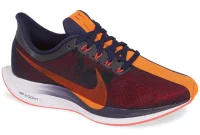Sneaker Tech: The Future of Sports Footwear
Emerging Technologies in Sneaker Design
In the world of sports footwear, the future lies in innovative and cutting-edge technologies. Sneaker manufacturers are constantly pushing the boundaries of design and performance to enhance the athletic experience. Here are some of the emerging technologies shaping the future of sneaker design:
1. 3D Printing
3D printing has revolutionized the sneaker industry by enabling the creation of intricate and customized shoe components. This technology allows designers to experiment with various materials, textures, and patterns, resulting in unique and personalized athletic shoes.
2. Advanced Materials
New materials, such as carbon fiber and graphene, are transforming the way sneakers are constructed. These lightweight and durable materials offer superior performance and allow for enhanced stability, flexibility, and energy return. Sneakers made with advanced materials can provide athletes with a competitive edge.
3. Smart Technology
Integrating smart technology into sneakers has opened up a whole new world of possibilities. Wearable sensors and embedded microchips can track various metrics like distance, speed, and heart rate. This data can be analyzed to provide valuable insights for athletes to optimize their performance and reduce the risk of injuries.
4. Sustainable Practices
As sustainability becomes a priority in the fashion industry, sneaker brands are adopting eco-friendly practices in their design and production processes. This includes using recycled materials, reducing waste, and incorporating sustainable manufacturing techniques. Sneakers that are both stylish and environmentally conscious are gaining popularity among conscious consumers.
5. Augmented Reality
Augmented reality (AR) technology is making its way into the sneaker industry, offering immersive and interactive experiences. Customers can use AR apps to try on virtual sneakers, customize their designs, and explore various colorways. This technology enhances the online shopping experience and helps customers make informed purchasing decisions.
The Role of AI and Machine Learning in Shoe Development
In today’s rapidly evolving world of sports footwear, the use of artificial intelligence (AI) and machine learning (ML) has become increasingly prevalent. These cutting-edge technologies are revolutionizing the way shoes are designed, developed, and manufactured, leading to the emergence of innovative and high-performance sneakers.
AI and ML algorithms are being employed to analyze vast amounts of data, including biomechanical information, foot measurements, and user feedback, to create shoes that offer optimal comfort, support, and performance. By leveraging AI and ML, shoe designers and engineers can enhance their understanding of human biomechanics and gain insights into the specific needs and preferences of athletes.
One of the significant contributions of AI and ML in shoe development is the ability to create personalized footwear. By analyzing individual data points and patterns, these technologies enable the customization of shoes to fit a particular individual’s foot shape, arch type, and gait pattern. This personalized approach enhances comfort, reduces the risk of injuries, and provides a tailored experience for each wearer.
Moreover, AI and ML algorithms are being utilized in the design phase to optimize shoe performance. Through data-driven simulations and virtual prototyping, shoe manufacturers can rapidly test different materials, patterns, and designs to identify the most efficient and effective configurations. This leads to the creation of shoes that deliver enhanced cushioning, stability, and energy return, ultimately improving athletic performance.
Furthermore, AI and ML have revolutionized the manufacturing process of sports footwear. These technologies enable automation and precision in various stages, including cutting, molding, and stitching, leading to improved efficiency and consistency. By reducing human errors and streamlining production, AI and ML enable faster turnaround times, allowing athletes to swiftly access the latest advancements in sports footwear technology.
In conclusion, the integration of AI and ML in shoe development is transforming the sports footwear industry. These technologies empower designers, engineers, and manufacturers to create highly personalized, technologically advanced, and reliable sneakers. With continued advancements in AI and ML, the future of sports footwear holds immense potential for innovation and performance enhancement.
Customization Options in Athletic Footwear
In the dynamic world of athletic footwear, customization options are taking center stage. Sneaker technology has evolved to not only enhance performance but also allow athletes to personalize their shoes according to their preferences. This article explores the exciting customization options available in athletic footwear and how they are shaping the future of sports shoes.
1. Color and Design
Gone are the days of limited color choices for sports shoes. Now, athletes can select from a broad range of colors and design patterns to reflect their style and individuality. Companies are offering customizing platforms where athletes can choose colors for different shoe parts, add personal logos, or even incorporate unique graphics.
2. Material Selection
With advancements in materials technology, athletes can now select from various materials for their shoe uppers. Whether they prefer lightweight mesh for breathability, water-resistant fabrics for outdoor activities, or more supportive materials for specific sports, customization allows athletes to optimize their footwear for their specific needs.
3. Fit and Comfort
Every athlete knows the importance of a perfect fit. Customization options now include the ability to choose shoe sizes, widths, and even personalized insoles. Athletes can enjoy a tailored fit that enhances comfort and performance, reducing the risk of injuries caused by ill-fitting footwear.
4. Performance Enhancements
Customization goes beyond aesthetics and fit; it also extends to performance features. Athletes can now customize their shoe cushioning, support systems, and even traction to suit their specific sport or playing style. This level of personalization helps athletes reach their full potential and improves overall athletic performance.
5. Smart Technology Integration
The future of athletic footwear lies in smart technology integration. Customization options now include the ability to embed sensors that track performance metrics such as distance, speed, and steps. Athletes can monitor their progress and make adjustments to their training based on real-time data from their personalized shoes.
In conclusion, customization options in athletic footwear have revolutionized the industry. Athletes can now express their style, optimize comfort and fit, enhance performance, and even integrate smart technology into their shoes. As the future of sports footwear continues to evolve, customization remains a key aspect that empowers athletes to perform at their best.
Wearable Tech Integration in Shoes
Sneaker Tech: The Future of Sports Footwear explores the exciting advancements in the integration of wearable technology in shoes. As technology continues to advance, it has found its way into various industries, including sports footwear. The incorporation of wearable tech in shoes brings a whole new level of functionality and performance to athletes and sports enthusiasts.
One of the key features of this emerging trend is the integration of fitness trackers and sensors within the footwear. These trackers and sensors are designed to provide real-time data on various aspects of physical performance, such as step count, distance traveled, speed, and even analyze the user’s gait. This information can help athletes monitor their progress, adjust their training routines, and prevent injuries.
Additionally, wearable tech integration in shoes also enhances safety. Some shoe models come equipped with built-in LED lights that improve visibility during low-light conditions, making them ideal for runners or cyclists. Others have GPS tracking capabilities that can be useful for outdoor activities, ensuring that users can always find their way back.
Another unique feature offered by wearable tech shoes is the ability to adapt to different terrains. Some shoes utilize sensors to adjust the cushioning and support levels based on the type of surface they are on, providing optimum comfort and reducing the risk of foot fatigue. This adaptability is particularly beneficial for athletes engaged in diverse sporting activities.
The integration of wearable tech in shoes is not limited to fitness and athletic performance. Some brands have also introduced smart shoes with embedded smartphone connectivity. These shoes can sync with mobile applications to provide notifications, track movement, and even control music playback via built-in sensors and Bluetooth technology. This seamless integration is revolutionizing the way we interact with our footwear.
In conclusion, wearable tech integration in shoes is transforming the sports footwear industry, offering enhanced performance tracking, safety features, adaptability, and even smart connectivity. As technology continues to advance, we can expect to see further innovations in this field. The future of sports footwear is here, promising a new era of functionality and performance for athletes and sport enthusiasts alike.
The Future of Footwear Sustainability
As the world becomes more conscious of the environmental impact of consumer goods, the future of sports footwear is being shaped by sustainability initiatives. The sneaker industry, in particular, is undergoing a transformation to reduce its carbon footprint and promote eco-friendly practices throughout the entire product life cycle.
One of the key focus areas in the future of footwear sustainability is materials. Shoe manufacturers are exploring innovative alternatives to traditional materials like leather and synthetic fabrics. For instance, some companies are experimenting with plant-based and recycled materials to create sneakers that are both stylish and sustainable. These eco-friendly options make it possible for consumers to enjoy trendy sneakers without contributing to deforestation or excessive waste.
Another aspect being addressed is manufacturing processes. Footwear companies are adopting greener production methods, such as using water-based adhesives and implementing more efficient manufacturing techniques to minimize energy consumption. Additionally, some brands are exploring 3D printing technology to create customized shoes, reducing material waste and the need for excess inventory.
Furthermore, end-of-life solutions are being developed to ensure a circular economy for sneakers. Companies are investing in recycling programs and exploring ways to extend the life of sneakers through repair and refurbishment services. Many are also encouraging consumers to donate used sneakers for recycling or partnering with organizations to repurpose them into new products.
The future of sports footwear also includes advancements in technology. Sneakers are increasingly being equipped with smart features such as step trackers, temperature control, and impact absorption systems. This integration of technology not only enhances performance but also presents opportunities for monitoring and improving the sustainability of footwear by tracking usage and promoting responsible disposal.
In conclusion, the future of sports footwear is headed towards sustainability. Through the development of eco-friendly materials, greener manufacturing processes, circular economy models, and technological advancements, the sneaker industry is taking significant steps towards reduced environmental impact. The tireless dedication towards sustainable practices will ensure a more environmentally conscious and responsible future for sports footwear.
Conclusion
In conclusion, the future of sports footwear lies in the evolution of sneaker tech. From advanced cushioning systems to smart sensors, athletes can expect enhanced performance, injury prevention, and personalized experiences. With ongoing innovation, the boundaries of what sports shoes can achieve are constantly pushed, making athletes more efficient and comfortable in their pursuit of victory.




